Top News
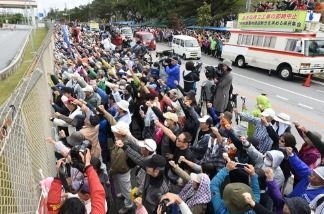
March 25, 2017 Ryukyu Shimpo Digital Edition
On March 25, the “prefectural people’s rally calling for immediate cancellation of unlawful land reclamation work and abandonment of the plan to build a new base in Henoko”, organized by the All Okinawa Coalition to Prevent Construction of a New Base in Henoko, was held in front of the gate to the U.S. military’s Camp Schwab. According to organizer estimates, more than 3,500 participants joined the rally.
Governor Takeshi Onaga attended the rally and announced, “with strength, I will absolutely revoke” the approval to reclaim land off the shore of Henoko, which is needed build the new base. It was the first time Governor Onaga clearly stated his intention to revoke the land reclamation approval. It was also the first time the governor attended a citizens’ rally in Henoko since taking office.
(English translation by T&CT and Sandi Aritza)
Go to Japanese

March 21, 2017 Ryukyu Shimpo
By Chie Tome
On March 17, a couple attempting a round-the-world trip, Frenchman Florent Asquinazi and Belgian woman Florence Nee, began their tour of Okinawa’s main island. They are starting out on their 320-kilometer excursion in Naha City, heading north up the island.
Askinazi and Nee were both working in the Republic of Ghana as engineers when they resolved to “experience the breadth of the world.” They bought a tandem bicycle in Europe and left on their trip.
Nee says with excitement: “We have heard that Okinawa has a distinctive history and culture, and that the people are bright and cheerful. We are looking forward to the sort of encounters we will have.”
In May 2015, the couple departed from Brussels, the capital city of Belgium, and took an excursion through South America, Oceania, and Asia that has lasted almost two years. After they passed through Taiwan, Okinawa marked the first stop on their trip to Japan, which is the 19th country or region they have visited. Following Japan, they will pass through South Korea and Russia, among other countries. They plan to finish their trip by returning to Brussels in about 10 months.
Askinazi says, “You only has one life, you must live it to the fullest.” He goes on to say with a smile that, “As long as Florence is with me, wherever we are I will be okay.”
(English translation by T&CT and Erin Jones)
Go to Japanese
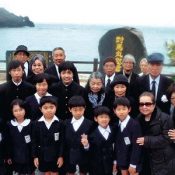
March 20, 2017 Ryukyu Shimpo
Midori Iwasaki reporting from Amami Oshima
The monument commemorating the evacuation boat “Tsushima Maru,” which was sunk by a torpedo attack from an American submarine in August, 1944, had its unveiling ceremony March 19 at Funoshi beach in Uken, on Amami Oshima in Kagoshima. Around 100 attendees, among which were 20 survivors and descendants from Okinawa, prayed for victims while looking out over the ocean.
According to a person involved with the monument on Amami Oshima, where a large number of victims floated ashore, “We created a place where descendants can memorialize [the event]. We hope that this place will tell later generations about the Tsushima Maru.”
There are two other memorials for the Tsushima Maru. The first is “Kozakura no To” in Wakasa, Naha; the other is in Akusekijima, part of the Tokara Islands in Kagoshima. Because there was no monument in Amami Oshima, up until now when descendants and survivors visited the island they lamented that there was no place for them to offer their prayers.
As the number of people who lived through this experience grows smaller, one person from Uken who was rescued at the time, Antoku Oshima , 90, said that, “The event must not be forgotten.” The people of the town listened, and formed a “Construction Executive Committee,” received funding from the town, and completed the construction.
Uken Mayor Nobuari Motoda said, “I hope this monument passes down the memory of the war, and is useful in educating the area about peace. Our mission is to continue sending this message.”
Keiko Taira, 82, from Ogimi, who was rescued after boarding the Tsushima Maru said, “The misery of the people of Amami Oshima must not be forgotten. Okinawan Vice-Governor Isho Urasaki commented, “I hope that many people will visit the memorial, and will continue to express the value of peace.” After the ceremony, the children of Uken received education materials about the Tsushima Maru from the Tsushima Maru Memorial Association.
(Translated by T&CT and Sam Grieb)
Go to Japanese
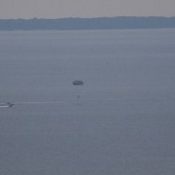
March 3, 2017 Ryukyu Shimpo
On March 16 shortly after 5 p.m., the U.S. Air Force conducted parachute drop training over the water at Tsuken Island Training Area in Uruma City. Okinawa Prefecture and Uruma City have repeatedly requested the cancellation of parachute drop training over the water. However, the U.S. military continues to conduct training ignoring local demands and claiming that Tsuken Island is an approved training area.
Around 5 p.m., a U.S. Air Force Special Operations MC-130 aircraft dropped at least three parachutes into the water.
The Okinawa Defense Bureau notified the City, neighboring municipalities and fishery cooperatives in advance about the plan to carry out training on the water surface on both days of the 16th and 17th.
(English translation by T&CT and Megumi Chibana)
Go to Japanese
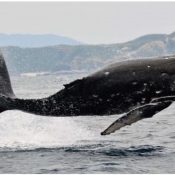
March 17, 2017 Ryukyu Shimpo
By Hirokazu Otsubo
Three whales jumped out of the water in a spectacular display near Fukaji Island, Zamami Village.
The scene was captured by Yasushi Sakurai, 56, from a ship on the morning of March 9.
It was his seventh year visiting Zamami, where he wanted to capture a whale breach. He had not had a chance to get the photo he wanted, and was frustrated.
“I extended to stay here one more night. I took a shot of the breach at the last minute. I feel so glad to have encountered this miraculous scene of the whale’s whole body leaping out of the water,” Sakurai said.
(English translation by T&CT)
Go to Japanese
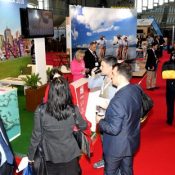
March 20, 2017 Ryukyu Shimpo
Asia’s largest airline business meeting “ROUTES ASIA 2017” (sponsored by UBM UK and UBM Japan) was held at the Okinawa Convention Center in Ginowan City from March 19 to 21.
It is the first time the meeting has been held in Japan.
Tourism operators in Okinawa say they expect the meeting, which is the largest business gathering of its kind in Asia, will be an opportunity to promote the attractiveness of Okinawa tourism and Naha Airport’s second runway, which will be completed in 2020. They also said it would help link new airlines with Okinawa.
Airline routes decision-makers and tourism development staff from about 200 airlines and about 300 airport companies from around the world took part in the event.
Leading global airlines, including Finnair, Finland’s flagship carrier, and Etihad Airways, the United Arab Emirates’ flagship carrier, which are interested in Asian routes, sent staff members to the business meeting.
Okinawa Governor Takeshi Onaga and Brand director of Routes from UBM group Steven Small were among those in attendance at the opening ceremony held on March 19.
Governor Onaga said in his greeting, “Having participants experience directly the nature and culture of Okinawa will, I hope, lead to new destinations connecting to Okinawa in the future.”
Director Small said to a Ryukyu Shimpo reporter he was convinced that Routes Asia being hosted in Okinawa would help the prefectural government, which aims to bring in 12 million tourists by the end of FY 2021.
“Routes” events are the world’s major business gatherings for launching airline routes. They have been organized every year since 1995 by UBM.
Every year, regional business meetings are held in Asia and North America. There is also a worldwide version, “World Routes”.
The prefectural government has been requesting to host “Routes Asia” in Okinawa since 2012.
“I visited Okinawa for the first time. Okinawa is a very attractive tourist spot,” said a participant who came from Singapore, and suggested investigating the possibility of opening a new route connecting to Okinawa in the future.
(English translation by T&CT)
Go to Japanese
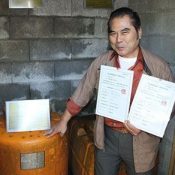
March 16, 2017 Ryukyu Shimpo
Yasuhiro Makishi (60), the famous habu hunter who has been catching habu (a viper native to Okinawa) in the mountains of the northern part of Okinawa’s main island for around 30 years, had his arrest dismissed by the Tokyo District Court on March 10. Makishi had been arrested on March 1st in Mihara, Nago, along with a Tokyo business partner for charges of keeping animals without permission. The charges stemmed from an investigation that began in December of last year, where Makishi was suspected of raising himehabu, an animal designated as dangerous under Japanese law for fear of its ability to cause harm to people. Makishi denied these charges, stating that he was not raising the vipers. However, to make absolutely sure that he could continue to catch snakes, Makishi obtained a “Dangerous animal raising and keeping permit” for habu and himehabu from the Okinawa Animal Welfare and Management Center on January 27.
According to Makishi, an investigator from the police department came to his house for a total of four days over the course of December, and from March 1 through March 8, he was detained at the police department. Makishi denied the accusations, stating, “I sell all of the habu I catch that same day. I only keep them in my house for around 1-2 hours, and I think that an investigator must have seen one of them. I am not raising them.” Furthermore, he noted that it is common for everyday people to capture habu and hand them over to the local government, stressing, “If what happened here was a crime, then [the police] would need to arrest everyone.”
A spokesperson for the Ministry of the Environment’s Animal Welfare and Management Office explains that with regards to animals that require a permit to keep under animal welfare law, “When dealing with dangerous animals, steps have to be taken that they cannot escape under any circumstances.” As for the standards for raising, the spokesperson states, “The amount of time that is allowable is not clearly regulated, it is a gray area. It is not something that is tightly decided,” and that the governing body issuing the permits have flexibility with how they handle cases.
(Translated by T&CT and Sam Grieb)
Go to Japanese
March 16, 2017 Ryukyu Shimpo
In fiscal 2015, 26,332 tons of ordinary waste was generated on U.S. bases in Okinawa, a 11.4% increase year on year. This was the first time that the amount of generated garbage exceeded 26,000 tons since fiscal 2010, and the largest amount of garbage generated in the past five years.
Because the U.S. military does not publicly announce the amount of garbage it generates per fiscal year, the Okinawa prefectural government arrived at the above figure through interviews with representatives at waste management facilities and the like. Of ordinary waste generated by the U.S. military in fiscal 2015, 6,500 tons (24.7%) was recycled, and 19,832 tons was disposed of by incineration or in a landfill.
Because the U.S. military stopped publicly announcing the number of military personnel, contractors and dependents after June 2011, the amount of waste generated per capita is unclear. In 2011, the total number of U.S. military personnel, contractors and dependents was 47,300. The numbers have likely changed over the years, making a direct comparison difficult, but if daily per capita waste generated in fiscal 2015 were calculated on the basis of the 2011 figure, it would come to 1,525 grams, which is 1.8 times the daily waste generated per capita by Okinawans in fiscal 2014 (844 grams).
In Okinawa, different cities, towns and villages each have their own stipulated method for separating garbage, but as a result of the exclusive jurisdiction set forth in Article 3 of the U.S.-Japan Status of Forces Agreement, Japanese laws and regulations do not apply on U.S. bases in Japan. The U.S.
Department of Defense has an environmental management program in place at all overseas U.S. bases that requires consideration be paid to the environment, but numerical trends show that the program is not having an effect.
A representative of a waste disposal facility in Okinawa that takes in U.S. military garbage said that the facility is contractually prohibited from publicizing any details, but admitted that “waste from the bases is hardly separated at all, and we separate it at the facility.” An official from the prefectural government’s Department of Environmental Affairs said that waste disposal sites in Okinawa are at full capacity and stated, “We will continue calling for the U.S. government to establish waste incineration facilities or the like under its own responsibility.”
(English translation by T&CT and Sandi Aritza)
Go to Japanese
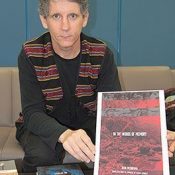
March 16, 2017 Ryukyu Shimpo
On June 13 Akutagawa Prize-winning novelist Shun Medoruma’s full-length novel Me no Oku no Mori (Kage Shobo Publishing, 2009) will be published as an English paperback version of the book titled In the Woods of Memory. This is the first time a piece of Okinawan literature has been translated to a full-length English version as a stand-alone book.
Professor Takuma Sminkey of Okinawa International University handled translation of the novel. He was born in the United States and moved to Okinawa in 2004 to take a new job at Okinawa International University. After moving there he began handling the translation of Okinawan literature.
Me no Oku no Mori was printed in the quarterly arts and culture journal Zen-ya (The Eve) from 2004 through 2007. Set on the northern part of Okinawa Island toward the end of the Battle of Okinawa, the book begins with an incident in which four American soldiers assault a young girl. The stories develop through the perspective of ten different people, including a young man who targets American soldiers to avenge the girl’s attack, and American soldiers who acted as assailants. This book depicts the sad chain of events leading up to the present. Medoruma linguistically experimented in the work, and among Medoruma’s literature it is considered his masterpiece.
Other English translations of Okinawan literature occurred in 1989 when Tatsuhiro Oshiro’s The Cocktail Party and Mineo Higashi’s Child of Okinawa were published together in one book as Okinawa: Two Postwar Novellas. Recently, University of Hawaii Press has been planning several anthologies compiling Okinawan modern poetry and short stories.
In the Woods of Memory is being published by Stone Bridge Books, a US publisher that publishes Japanese and Chinese literature in translation, among other things. In Japan the retail price will be 1,965 yen.
(English translation by T&CT and Erin Jones)
Go to Japanese
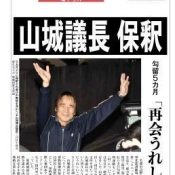
March 18, 2017 Ryukyu Shimpo Digital Edition
Okinawa Peace Movement Center Chairman Hiroji Yamashiro, 64, had been detained for approximately five months for his protest activities regarding the new base construction in Henoko of Nago and the U.S. military Northern Training Area helipad construction. He was prosecuted for forcible obstruction of business, obstruction of official business, inflicting bodily harm, and destruction of property. On the afternoon of March 18, the Naha Branch of the Fukuoka High Court decided to dismiss the appeal made by the Naha District Public Prosecutor’s Office. Yamashiro paid his bail and left the Naha Detention Center around 8 p.m. the same day. Supporters who had gathered welcomed him with applause.
On March 17, the Naha District Court decided on granting Yamashiro’s bail. However, dissatisfied with this decision, the Naha District Public Prosecutor’s Office appealed to the Naha Branch of the Fukuoka High Court on the same day.
(English translation by T&CT and Chelsea Ashimine)
Go to Japanese

March 8, 2017 Ryukyu Shimpo
An eighteen-year old senior student of Awase special-needs school, Marika Ishikawa, passed the entrance exam for the Department of British and American Language and Culture, College of Global and Regional Culture at the Okinawa International University. Ishikawa is quadriplegic due to cerebral palsy. From her neck down, she only has movement in her right hand, but she can move her thumb well enough to use a tablet computer. She expects her new phase of life to bring new perspectives and opportunities; “Although my current dream is to be a translator, I would like to find new dreams through the widened perspective college life will give me.” Ishikawa became interested in English listening to English songs in her class when she was in the second grade. She started to listen to her favorite singers’ songs and to type English words on the tablet devise to learn the language. After continuing these efforts, she passed the pre-level 2 English Language Proficiency test in June, 2016. Ishikawa started to look into studying at college in her first year in the high school program, and she visited open campus events and spoke to senior students who studied at universities while dealing with the same condition as her. She shared her passion for university at the interview to make her dream come true to enter the college.
Her 49-year old mother, Misayo, surprised by the good news, said, “She was a child who did not like studying at all.” She says of her daughter’s next step, “I hope she will be considerate of others and make good friends.”
Ishikawa will receive assistance to commute to school. She also plans to receive assistance from the university during classes, but the support will be limited to only about twice per week. Ishikawa requested both her university and Ginowan city office provide more support for her solo study. She received a positive answer from the university saying the school will secure the budget and consider the request.
Ishikawa is excited to begin her campus life in April, “There is a lot to look forward to.”
(English translation by T&CT and Sayaka Sakuma)
Go to Japanese










 Webcam(Kokusai Street)
Webcam(Kokusai Street)


